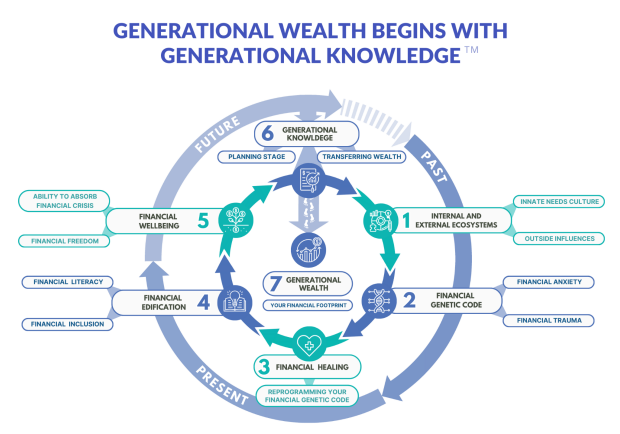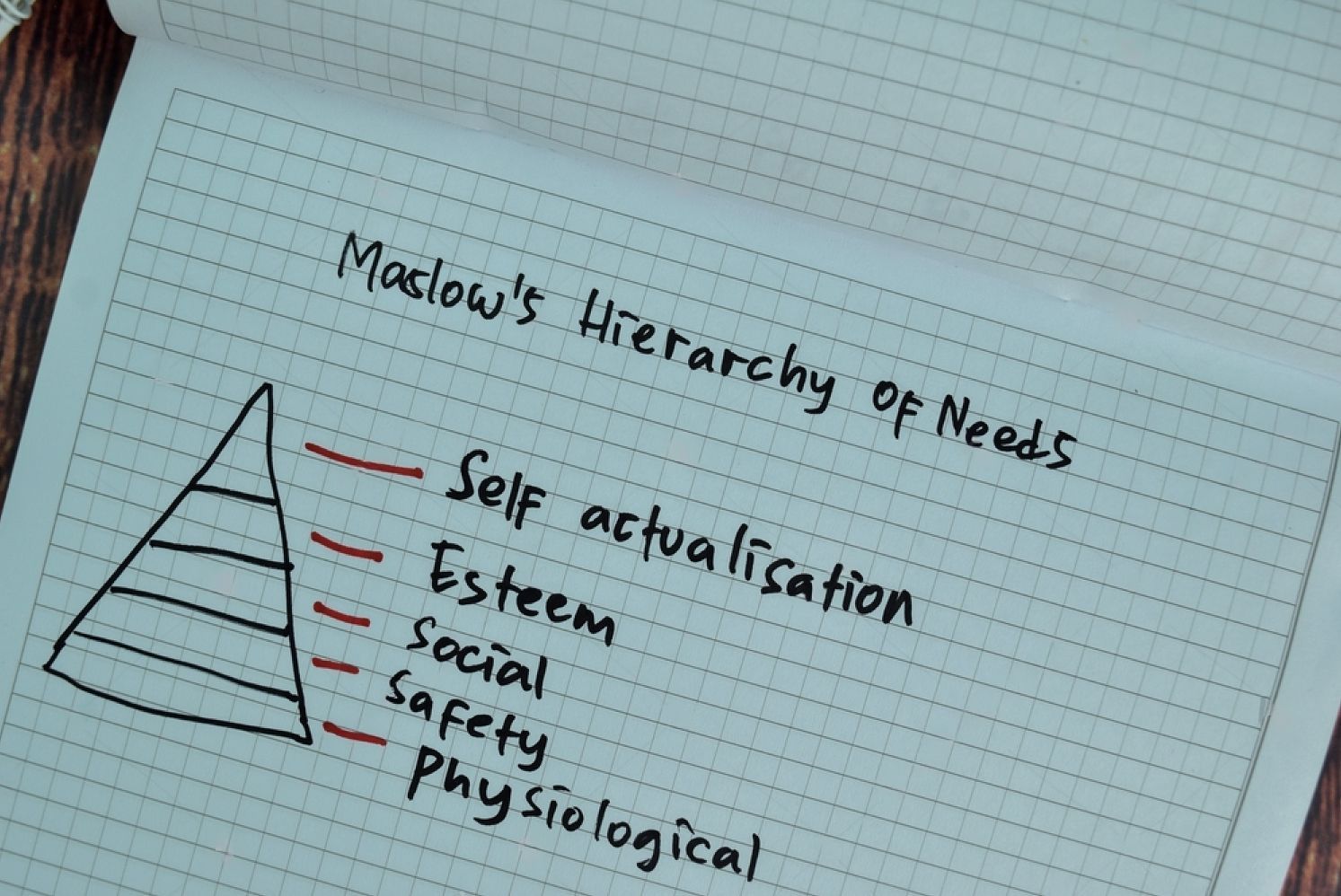GENERATIONAL WEALTH BEGINS WITH GENERATIONAL KNOWLEDGE™

Implementing the Generational Wealth Model in Financial Services
As a financial professional – whether a financial counselor, therapist, educator, advisor, or planner – it’s your responsibility to understand where your clients are in their financial journey. You are the one who is entrusted to walk them from where they are currently to the life of prosperity and security that they’re craving - in essence, you’re acting as their financial fiduciary. While there are countless vehicles that you can implement to help your clients achieve these results, you need a system in place that can work for every client, no matter what level they’re starting from.
Some clients come in with pre-existing beliefs and mindset blocks from their past. Some come with a leg-up, and some inherit wealth. Some clients have had in-depth money conversations at home, while others need help understanding how to manage their money or achieve their financial goals.
No matter where your clients are in their journey, it would be best to have a system that can meet them where they are and walk them through all of the necessary touchpoints to achieve their goals, whether financial well-being or establishing wealth that can last and withstand future generations.
That’s where the Generational Wealth Model can elevate the industry. The Generational Wealth Model (see above) is a seven-stage model that walks you through the process from understanding your client’s internal and external ecosystems to establishing longstanding generational wealth for generations to come.
In this third installment of my five-part series (check out the rest for information about the model and how to navigate each of the seven steps), I will discuss how the Generational Wealth Model applies to financial service providers and how they help their clients.

Why do financial professionals need the Generational Wealth Model?
The Generational Wealth Model is a game-changer for financial service providers because it allows them to take a holistic inventory of their client’s financial situation from a behavioral and strategic standpoint. This is how they can understand the steps they need to take to achieve their goals as individuals and as a family.
Moreover, the seven-stage Generational Wealth Model provides financial educators, counselors, therapists, advisors, and planners with a detailed roadmap of the different stages a client must work through to achieve results without regressing or skipping integral aspects of a robust financial foundation.
It is essential to mention that clients may oscillate both backward and forward throughout the model – moving clockwise, counterclockwise, and migrating between different phases of the model – depending upon their current situation and flashpoints that may cause clients to revisit previous stages within the model on an on-going basis. “[The model] is a great tool to educate not only the consumer of financial services but also the provider of financial services. This is a model that goes both ways to catapult the industry to where it needs to be.” - Dominique Henderson, The New Wealth Wave Podcast: Episode 18
Therefore, you can help clients invest their money strategically to plan retirement. Still, if you don’t first understand their financial behaviors and what has created their existing money story, they will not be equipped with the right tools and mindset to manage their money in a way that will last for future generations. Thus, you must meet the client where they are in their life stage and provide solutions to place them in the best position as they advance.
Aside from growing their assets, financial professionals help their clients succeed in mindset and security. Achieving growth in all these aspects is nearly impossible without breaking down the underlying environments and behaviors and reprogramming them to allow for success in the future.
You may be helping your clients through Stage 4 or Stage 5, but if they have not yet walked through Stages 1-3 without identifying the various hidden barriers that have become a significant part of their Financial Genetic Code, “Stage 2” of the model, the likelihood of long-lasting success decreases.
How to implement the model in your financial services:
Now that you understand why the Generational Wealth Model is crucial for helping clients achieve long-lasting financial success let’s learn how to implement the model in your financial services.
The Generational Wealth Model starts by addressing the internal and external ecosystem (Stage 1) that your clients have. This includes things like their mindset, beliefs, behaviors, and outside influences, e.g., education, safety, and systemic policies, which are paramount in one's external ecosystem. For that reason, by understanding this ecosystem, you can comprehend the complexities of their financial genetic code (Stage 2), directly attributed to their internal and external ecosystem. For that reason, Clients’ financial genetic codes are made up of the anxieties and traumas that exist due to their pre-existing ecosystems.

Only once you understand a client’s financial genetic code and the mechanisms from which it stems can you, as a financial professional, albeit a financial therapist, begin to work with the client to begin the journey of reprogramming their genetic code (Stage 3) to stimulate incremental growth and positive success going forward.
Your clients must have the right mindsets and beliefs to build on before they are ready to undergo the financial edification (Stage 4) process, where financial professionals such as financial advisors or planners typically begin with their clients.
The financial edification process involves building financial literacy and understanding financial inclusivity to become more aware of the tools and opportunities that can create financial prosperity in the future. This is when financial advisors provide their clients with the appropriate knowledge and access to the information necessary to make educated financial decisions together. This process is critical; however, when clients are provided these tools without walking through the previous steps, they add bricks to a broken house.
As a financial advisor or planner, the goal is typically to achieve financial well-being (Stage 5). In the Generational Wealth Model, financial well-being represents the culmination of all the previous stages to create financial freedom and the ability to absorb financial crises and, most importantly, not to outlive your income. This is the goal that many advisors build toward with their clients. You must support your clients through this stage, as an estimated 70% of Americans feel financially stressed. More than ever, your clients need guidance and clarity as they work toward financial well-being.
When the time comes to transition from financial well-being to focusing on generational knowledge, you may find yourself moving from working primarily with a financial advisor to engaging a financial planner who takes a more holistic approach. However, this doesn’t mean you must switch entirely; a trusted financial advisor can also play a crucial role in these later stages, especially if you already have an established relationship built on trust.
A stage that planners typically focus on with their clients is generational knowledge (Stage 6), where they usually work with their clients to create long-term plans for things like estate planning, life insurance, and long-term care to prepare for wealth preservation in the future. The Slogan “Generational Wealth Begins With Generational Knowledge ™ “was born in this stage.
In the model, this stage best serves to help prepare for the end goal, generational wealth, thus creating your financial footprints (Stage 7), where you strategically pass on your assets and the knowledge, values, and principles that create individual and inter-generational financial wellbeing. Many advisors work with their clients to get to this stage; however, only some advisors have a system in place that is solid enough to ensure that clients can reach this stage no matter what their starting point is.
The bottom line.
The Generational Wealth Model can completely alter the future of the financial services industry. While many service providers incorporate some of the key aspects of the model into their existing services, the model provides a roadmap that encapsulates every aspect of a holistic plan to address the underlying financial beliefs and behaviors that hold many clients back from achieving their long-term financial goals.
The Generational Wealth Model is paramount for advisors because it ensures every key element is noticed and every client gets included, regardless of their financial background.
By having a process that addresses the past, present, and future of their clients' journeys, financial professionals can provide their clients with the most effective and comprehensive services and make the most significant long-term impact on them.
To learn more about the Generational Wealth Model, listen to the New Wealth Wave Podcast or check me out below!
Listen to episodes with Nate Astle and Dominique Henderson.




Schedule an individual or speaking engagement with Dr. Wallace today.
All Rights Reserved | Dr. Joaquin Wallace



